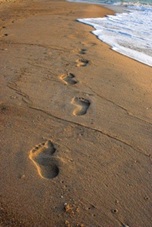Courtesy of http://www.123rf.com/
Proud mothers get footprints of their babies’ immortalized using plaster. When we walk along the beach our footprints can be washed away with the incoming tide.
What of the digital footprints students leave behind in the form of blogs? In reality these digital footprints are more of the plaster type of footprint casts while their authors might see them as more of footprints in the sand, created once and never used again.
What is to prevent a future employer or worse, an identify thief, to find out about you through the blogs you leave behind? There is no security or password protection on these sites. Your name and personal details, if you share them, are all parts of a puzzle that identify thieves may use against you (Goodridge, 2009). Yet, we put them on our blogs for the entire world to see.
Pang (2009) gave examples of student blogs in his article. They were all still available even though some of the posts were from 2006. Perusing these blogs showed typical college students. However, photos of one lifting a glass of alcohol, which was shown on one these blog sites, might not give a future employer the most favorable impression of a candidate seeking a job.
Pang (2009) discusses how blogs allow students to become capable of taking charge of their own learning and to develop into independent lifelong learners. Personally, I did not find evidence in his article to support these claims. Especially the last claim, a claim that is certainly not provable given the short length of the study which was a single college semester.
Will these digital footprints yield the results that Pang so optimistically describes? Or will they be like footprints in the sand – forgotten by the people who created them in their quest of moving forward and never to be used again? Or will they be footprints in plaster, where others can harvest information maybe even for malicious purposes? Only time will tell.
REFERENCES
Goodridge, E. (2009). Steps to prevent identity theft, and what to do if it happens [Article]. Retrieved July 4, 2013 from http://www.nytimes.com/2009/05/02/your-money/identity-theft/02idtheftprimer.html?pagewanted=all&_r=0
Pang, L. (2009). Application of blogs to support reflective learning journals. Retrieved May 21, 2009, from http://deoracle.org/online-pedagogy/teaching-strategies/application-of-blogs.html

